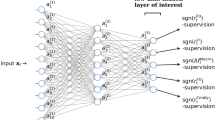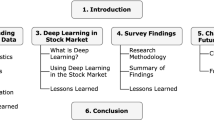Abstract
This paper proposes a novel agent-based model combining private information diffusion to explain time-series momentum and reversal. Private information transmission allows heterogeneous trading strategies coexist in the artificial market. The experiments reproduce momentum in short horizon and reversal in long horizon in the artificial financial market. Moreover, the authors also analyze how the private information contagion affects the momentum. Meanwhile, the authors find the significant price trend and excess volatility of volume when private information diffuses gradually.
Similar content being viewed by others
References
Jegadeesh N and Titman S, Returns to buying winners and selling losers: Implications for stock market efficiency, The Journal of Finance, 1993, 48(1): 65–91.
Rouwenhorst K G, International momentum strategies, The Journal of Finance, 1998, 53(1): 267–284.
Moskowitz T J and Grinblatt M, Do industries explain momentum? The Journal of Finance, 1999, 54(4): 1249–1290.
Fama E F and French K R, Size, value, and momentum in international stock returns, Journal of Financial Economics, 2012, 105(3): 457–472.
Asness C S, Moskowitz T J, and Pedersen L H, Value and momentum everywhere, The Journal of Finance, 2013, 68(3): 929–985.
Moskowitz T J, Ooi Y H, and Pedersen L H, Time-series momentum, Journal of Financial Economics, 2012, 104(2): 228–250.
Hong K H J and Satchell S, The sensitivity of beta to the time horizon when log prices follow an Ornstein-Uhlenbeck process, The European Journal of Finance, 2014, 20(3): 264–290.
He X Z and Li K, Profitability of time-series momentum, Journal of Banking and Finance, 2015, 53: 140–157.
Marshall B R, Nguyen N H, and Visaltanachoti N, Time-series momentum and moving average trading rules, Quantitative Finance, 2017, 17(3): 405–421.
Andrei D and Cujean J, Information percolation, momentum and reversal, Journal of Financial Economics, 2017, 123(3): 617–645.
Arthur W B, Holland J H, Lebaron B, et al., Asset pricing under endogenous expectations in an artificial stock market, The Economy as an Evolving Complex System II, 1999, 26(2): 15–44.
LeBaron B, Arthur W B, and Palmer R, Time-series properties of an artificial stock market, Journal of Economic Dynamics and Control, 1999, 23(9): 1487–1516.
Yang H J and Sun G P, Study on the stability of an artificial stock option market based on bidirectional conduction, Entropy, 2013, 15(2): 700–720.
Liu Y F, Zhang W, Xu C, et al., Impact of information cost and switching of trading strategies in an artificial stock market, Physica A: Statistical Mechanics and Its Applications, 2014, 407: 204–215.
Liu X, Zhang W, Xiong X, et al., Credit rationing and the simulation of bank-small and medium sized firm artificial credit market, Journal of Systems Science and Complexity, 2016, 29(4): 991–1017.
Barde S, Direct comparison of agent-based models of herding in financial markets, Journal of Economic Dynamics and Control, 2016, 73: 329–353.
Goykhman M, Wealth dynamics in a sentiment-driven market, Physica A: Statistical Mechanics and Its Applications, 2017, 488: 132–148.
Demirer R, Lien D, and Zhang H, Industry herding and momentum strategies, Pacific Basin Finance Journal, 2015, 32: 95–110.
Yan Z, Zhao Y, and Sun L, Industry herding and momentum, The Journal of Investing, 2012, 21(1): 89–96.
Grossman S J and Stiglitz J E, On the impossibility of informationally efficient markets, The American Economic Review, 1980, 70(3): 393–408.
Vives X, Short-term investment and the informational efficiency of the market, The Review of Financial Studies, 1995, 8(1): 125–160.
Hong D, Hong H G, and Ungureanu A, An epidemiological approach to opinion and price-volume dynamics, AFA Meetings, Chicago, 2012.
Duffie D and Manso G, Information percolation in large markets, The American Economic Review, 2007, 97(2): 203–209.
Duffie D, Malamud S, and Manso G, Information percolation with equilibrium search dynamics, Econometrica, 2009, 77(5): 1513–1574.
Beja A and Goldman M B, On the dynamic behavior of prices in disequilibrium, The Journal of Finance, 1980, 35(2): 235–248.
Barber B M and Odean T, Online investors: Do the slow die first? The Review of Financial Studies, 2002, 15(2): 455–488.
Choi J J, Laibson D, and Metrick A, How does the Internet affect trading? Evidence from investor behavior in 401 (k) plans, Journal of Financial Economics, 2002, 64(3): 397–421.
Griffin J M and Nardari F, Do investors trade more when stocks have performed well? Evidence from 46 countries, Review of Financial Studies, 2007, 20(3): 905–951.
Collin-Dufresne P and Daniel K, Liquidity and return reversals, Columbia GSB Working Paper, 2014.
Barberis N, Shleifer A, and Vishny R, A model of investor sentiment, Journal of Financial Economics, 1998, 49(3): 307–343.
Author information
Authors and Affiliations
Corresponding author
Additional information
This research was supported by the National Natural Science Foundation of China under Grant Nos. 71771006 and 71771008.
This paper was recommended for publication by Editor YANG Xiaoguang.
Rights and permissions
About this article
Cite this article
Wang, Z., Liu, S., Yang, H. et al. An Agent-Based Approach for Time-Series Momentum and Reversal. J Syst Sci Complex 33, 461–474 (2020). https://doi.org/10.1007/s11424-020-8042-2
Received:
Revised:
Published:
Issue Date:
DOI: https://doi.org/10.1007/s11424-020-8042-2




